Pamukkale was a place we had heard the name of, but didn’t really know much about. We’re pretty light on the planning at the best of times and being a short trip, most of our attention had been focused on the seeing the ‘big three’ – Istanbul, Cappadocia, Ephesus – then visiting our family friends in Alacati for the final few days. All we knew of Pamukkale was that there were some hot springs (good, we like those), some ruins (history and culture – also good) and a hillside covered in white stuff called the Cotton Castle (confusing – better check it out!). So with that knowledge, we figured on a one-night stopover to have a quick look around on the way from Cappadocia to Alacati – job done! But then we received a message from Koray, a local resident of Pamukkale who had seen come across our Facebook and decided to show us just how much the little town had to offer! He even offered to organize our accommodation and connect us with the local mayor’s office! This sounded great, so we added an extra day to our time in this now slightly more intriguing place.
How to get to Pamukkale
Getting to Pamukkale from Cappadocia was easy, we simply flew from Kayseri airport to Denizli airport. Internal flights are extremely cheap in Turkey and can cost as little as $20 each way, or even less if you book way in advance.
Check out some of the cool and cheap tours you could do in Kayseri.
Buses are also very good in Turkey and you can travel the entire country quite cheaply and in comfort. One of the best companies is Pamukkale Turizm, which we used to travel to Izmir.
Check the location of your accommodation as most of the higher-end hotels are not in Pamukkale itself, but in one of the 2 closest small towns, which are all with 5 minutes of each other. Getting around is easy with local minibuses driving back and forth all day, which cost only several Lira.
When we arrived at Denizli airport, Koray had arranged a private airport taxi for the one hour drive to our hotel in the small town of Karahayit, just a few minutes from Pamukkale itself. You can also take a group shuttle from the airport, which will be a lot cheaper.
Our hotel in Pamukkale
Check prices and availability of hotels in Pamukkale in Booking.com
Koray and the Mayor’s office of Pamukkale truly had really organized the best accommodation for us in the whole area! Doga Thermal Hotel and Spa is probably the newest five-star hotel in the region and is built like a modern palace, designed around a central swimming pool, spa and outdoor natural thermal pool.
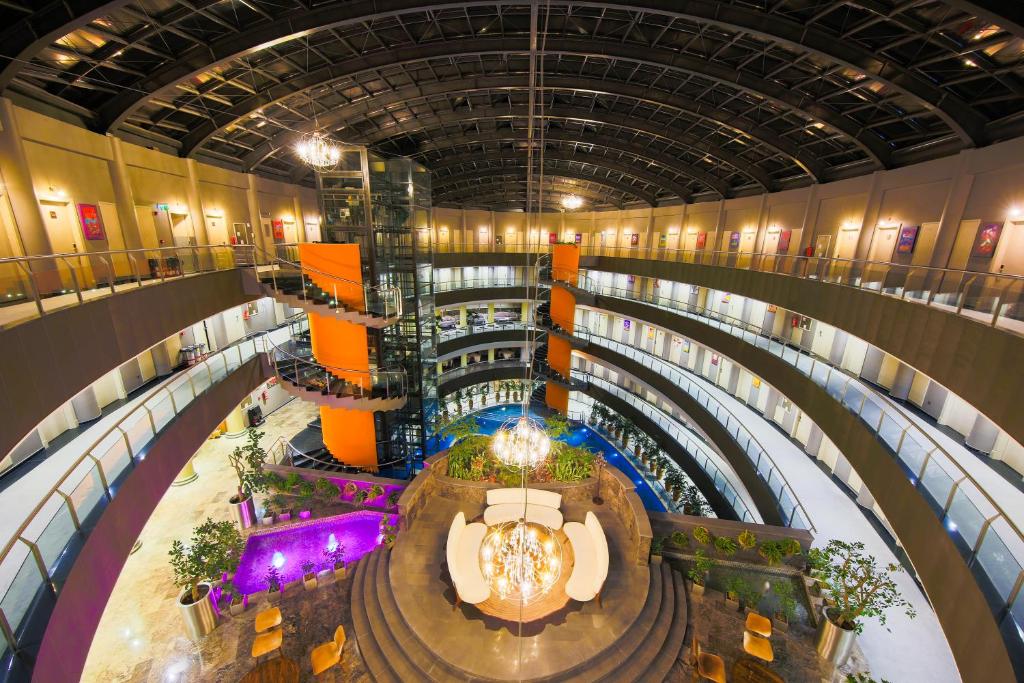
The hotel comprises 5 floors of luxury rooms arranged in a large oval around a five-story atrium which lights the indoor pool and Jacuzzi spa in the middle of it.
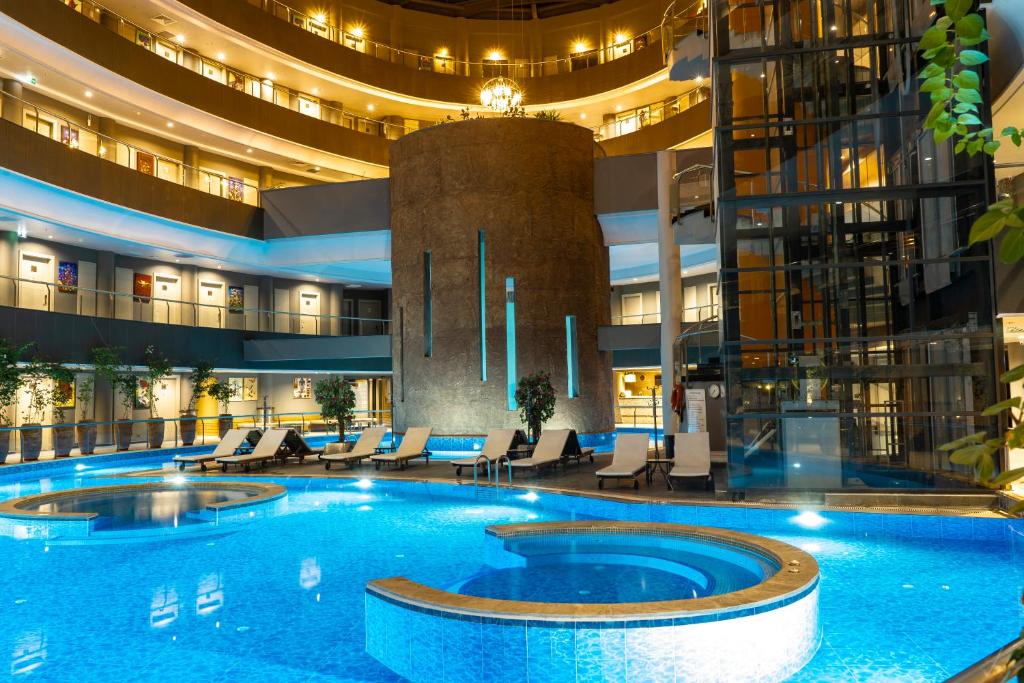
On the ground floor is a spa with a dry sauna, Turkish steam room, ice fountain and even a salt therapy room! The real attraction is outside though – the huge thermal pool is always at least 40 degrees Celsius and is fed by the natural hot spring which runs underneath the entire area. Locals say that studies of the water here show up to double the beneficial mineral content compared to thermal springs in other, more famous, European countries. People of all ages come here to benefit from the natural health properties of the water here, often in combination with other treatments like physiotherapy.
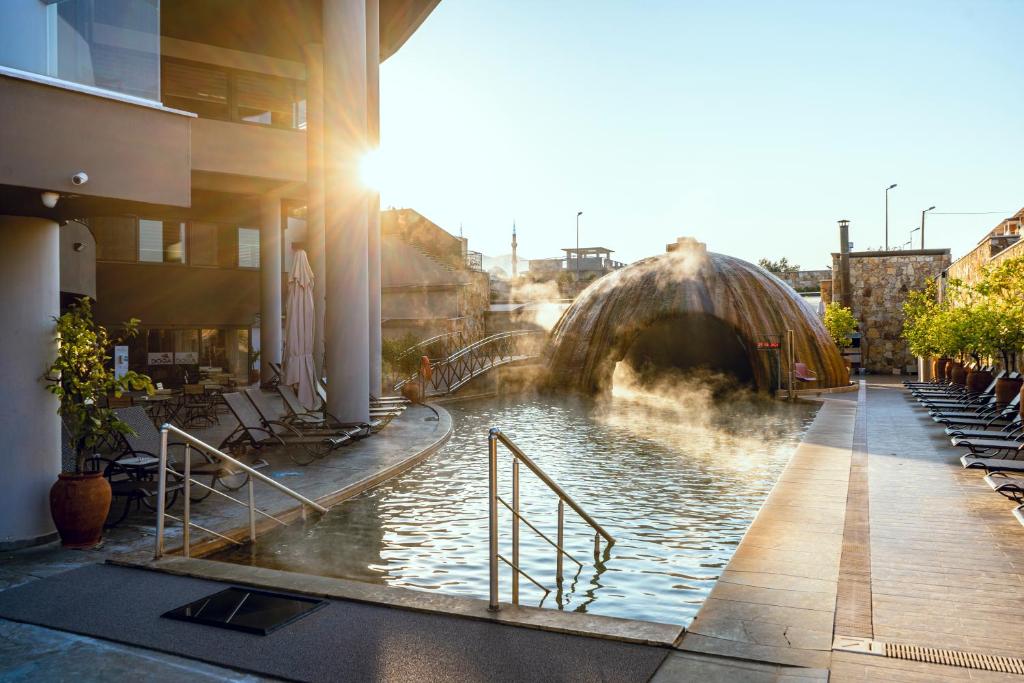
Our room was very big with a private balcony and all the mod cons like climate control and cable TV. The bathroom featured a solid stone designer basin, a rainforest shower and a bathtub with a window onto the bedroom (in case you like to share…).
Dinner in the hotel restaurant was a big buffet with all kind of local Turkish and international food, plus an amazing range of colorful deserts.
Breakfast was just as amazing, with real home-made Turkish yogurt and natural honey which looked like it was taken straight from the hive!
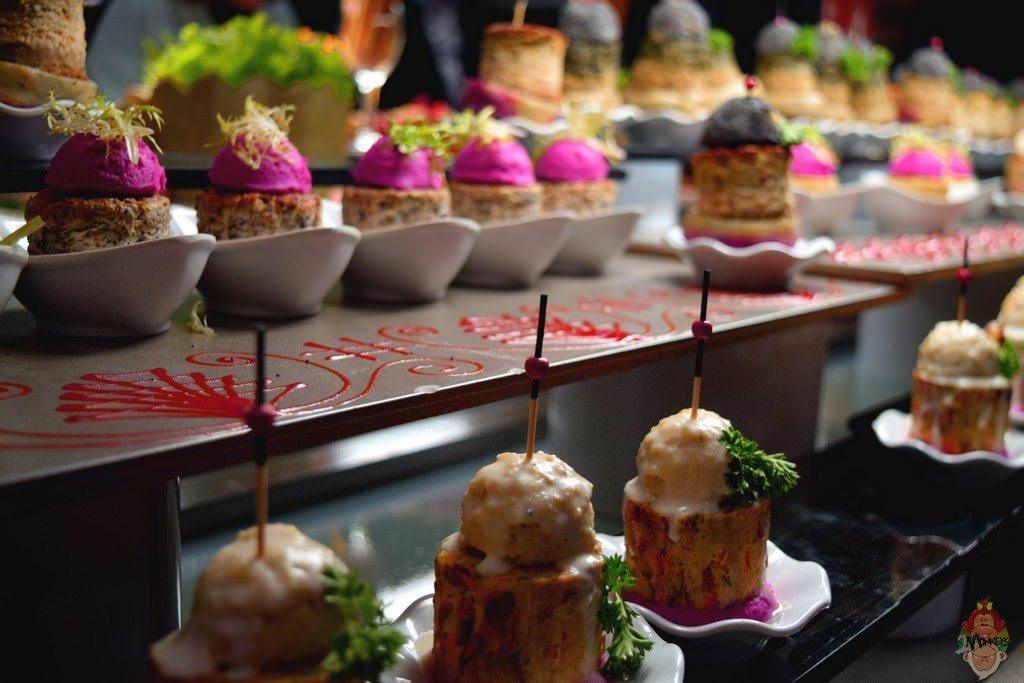
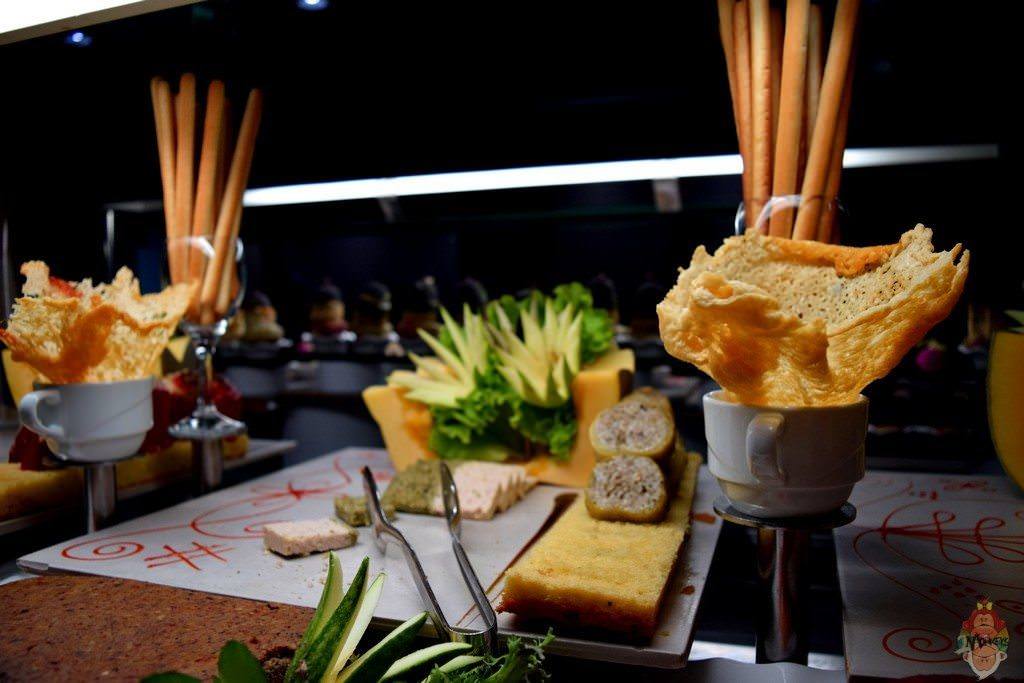
Meeting the Mayor of Pamukkale
The next day, Koray had arranged for us to meet with the mayor of Pamukkale, so we could find out a bit more about what makes the area so special.
We spent the whole morning in the outdoor thermal spa, relaxing and trying to soak up as many of the magic minerals as possible to keep us going until the next thermal spa we manage to find!
Our meeting with the mayor took place in Denizli, the nearest administrative city about 45 minutes away by the same minibuses that take you around the local area.
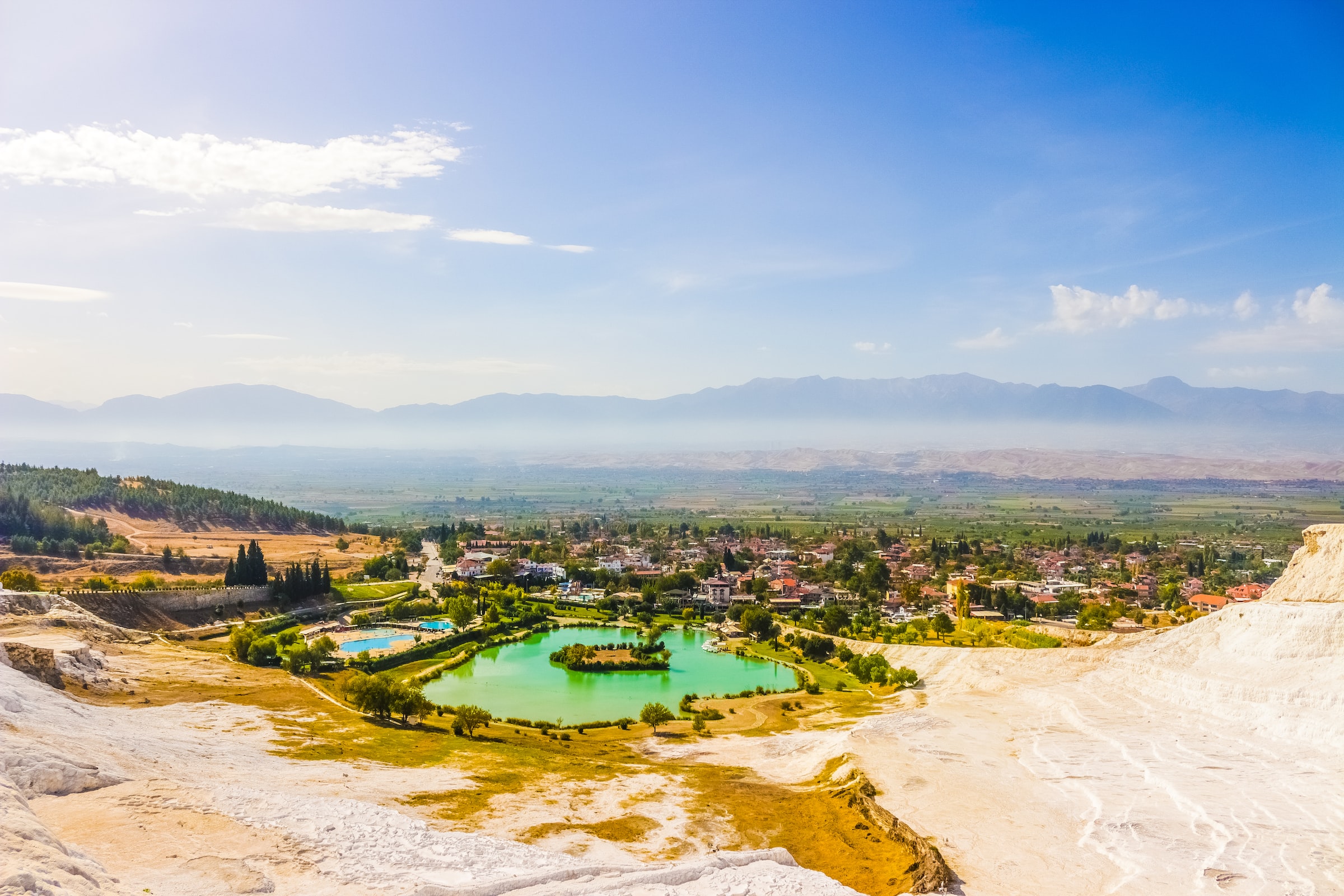
First we met Arkan, the Mayor’s right hand man, who explained that this is the first year Pamukkale was being governed by its own mayor and that they had a lot of big plans for the area. First and foremost, they plan to carry a major clean-up of the area, restoring it back to its state of natural beauty, yet at the same time, developing the area into a center of natural health and well-being. This includes connecting all the different areas by pathways, cycle ways and nature walks, as well as promoting the area for outdoor adventure sports. So it sounded like there were a lot of big plans on the way which would deal with all the things we had noticed about the area – mainly that there was a lot of very cool stuff here, but that the whole area was very fragmented and in need of a little work to smooth some rough edges caused by poorly managed past developments. The Mayor himself appeared to have an open door policy, meaning any of his constituents could come and visit him to voice any problems they were having. When we did meet with him, he was very keen to let us know which direction the area was heading in and that in not too long they would be starting to promote the area much more heavily as a tourist destination.
All in all, it was interesting to get to hear the kind of plans that the new mayor has for the area and that we can look forward to hearing a lot more about Pamukkale in the near future.
That evening we retreated back to our hotel, to the indulgent buffet and the warmth of the healing waters!
Pamukkale Travertines and Hierapolis
Surprisingly, although we had really enjoyed our time in Pamukkale, we had yet to see the two main attractions of the area – the travertines of the ‘Cotton Castle’ and the ancient city of Hierapolis, both designated UNESCO Heritage sites.
Check out some of the cool and cheap tours you could do in Hierapolis.
Undoubtedly the main attraction of Pamukkale has to be the vast white terraces formed by the flow of natural, hot spring water which is so super-saturated with calcium and minerals that it has been deposited over thousands of years. They are a spectacular site, even resembling snow from a distance.
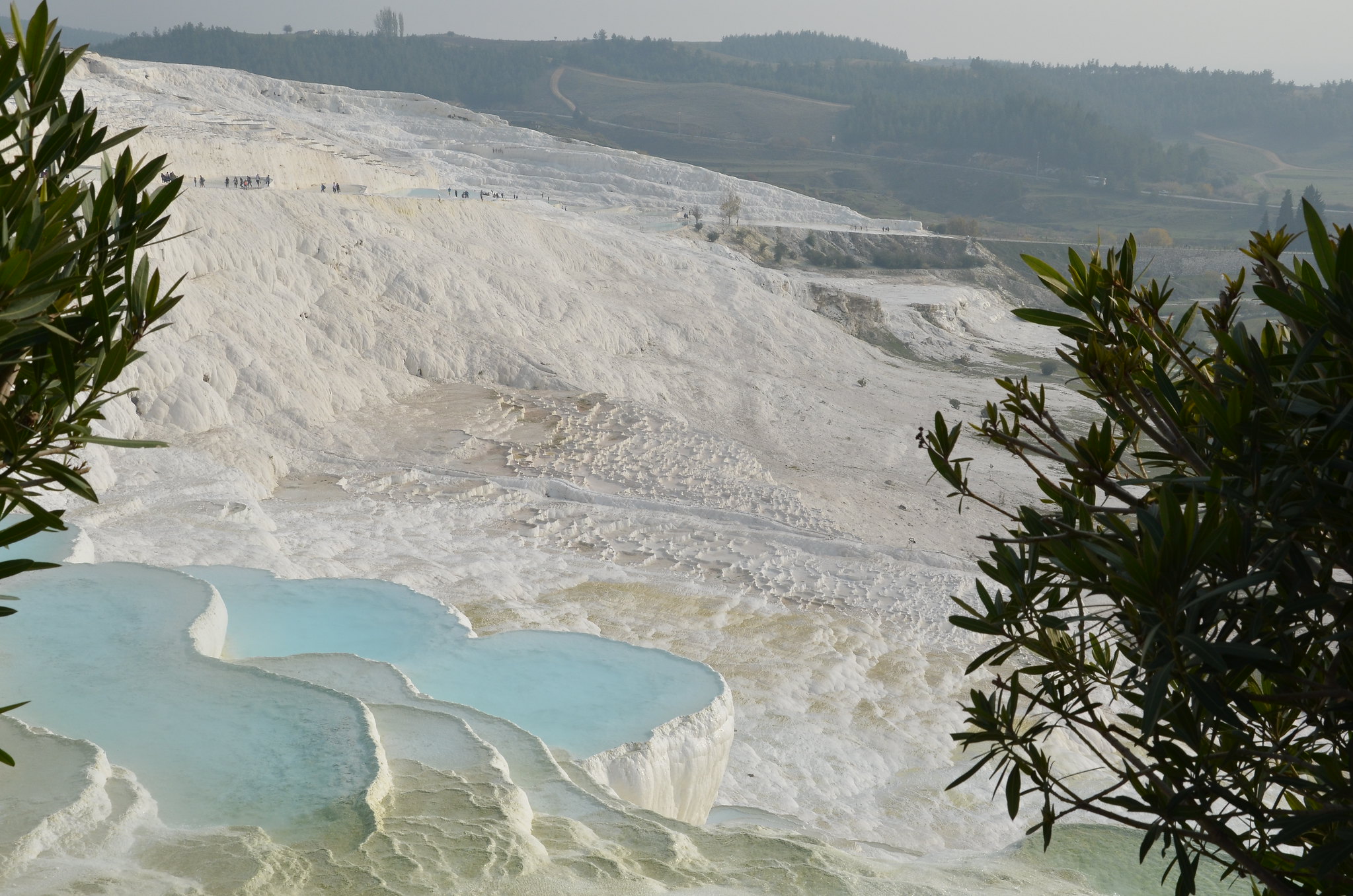
You can walk up the travertines for an entrance fee of about 50 Lira, which also includes entrance to Hierapolis at the top. The only rules are that you must remove your shoes and must only walk in the permitted areas or bathe in certain allowed pools. Apparently there area was badly damaged in the past by hotel developments and even an actual road (?!) which were all built directly on top of the site, but these have all been removed and the site is now highly protected.
The water is warm, silky smooth and full of minerals which you can gather in your hand from the bottom of the pools and spread like a paste over your skin so that you can almost feel your skin absorbing the goodness!
The walk up is gentle and quite easy, the solidified calcium providing plenty of grip under your bare feet. There are plenty of places to stop and swim and very few where you need to be careful of slipping.
Turning around while climbing the slope will give you a spectacular panoramic view of the natural landscape of Pamukkale.
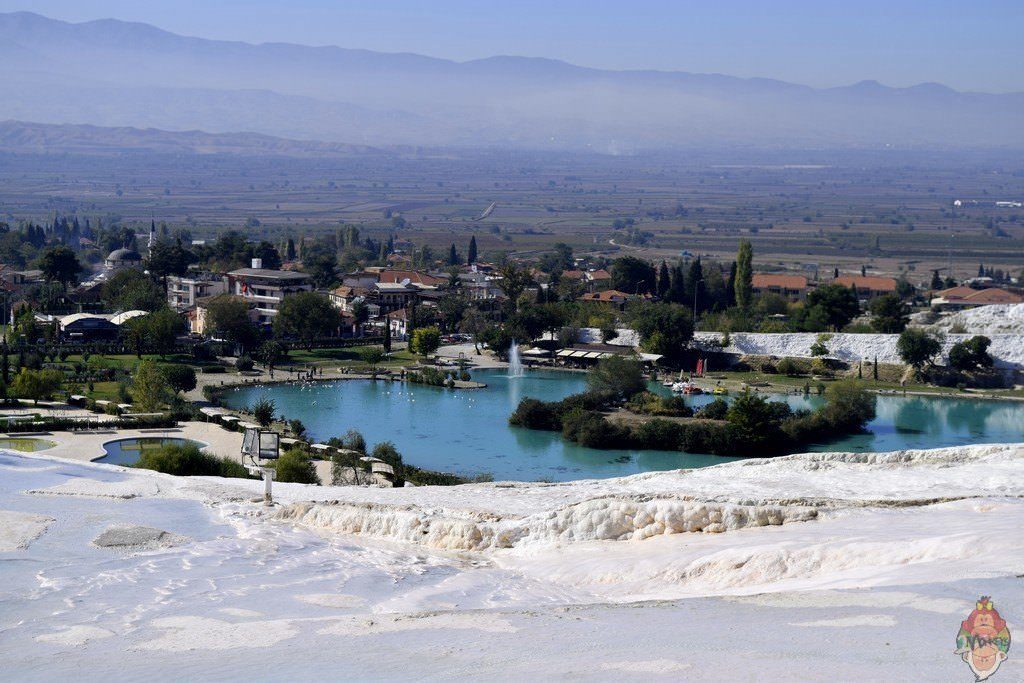
At the top of the travertines you can put your shoes back on as you catch your first glimpse of Hierapolis. Very little is known about the beginnings of the city, only that there is no evidence of Persians having been here and that a temple was built here on the 3rd century BC. What then grew into the city of Hierapolis became a thermal spa and healing center where doctors would send their patients, many of whom felt so rejuvenated that they retired there. It’s interesting that the new local government is now working to revive Pamukkale as exactly that – a center for natural healing.
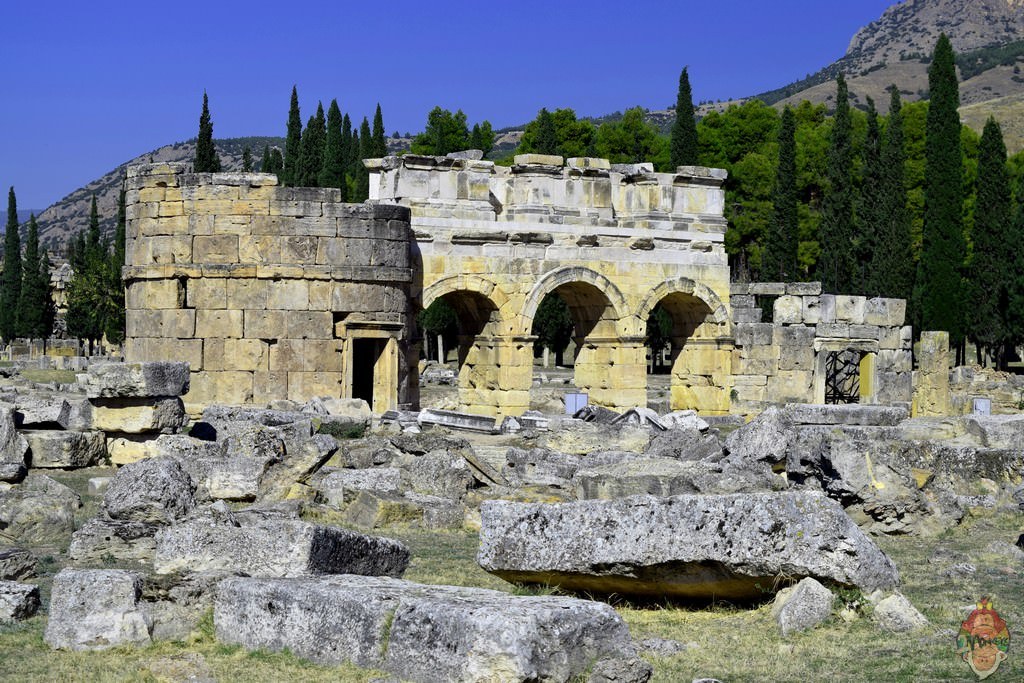
You could easily spend a couple of days exploring the city, but the main standing structures are the Main Street, the Frontinus Gate, the 50 row theatre, the Temple of Apollo and ancient baths, including Cleopatra’s Pool and the Antique Pool.
Check out some of the cool and cheap tours you could do in Temple of Apollo / Temple of Apollo.
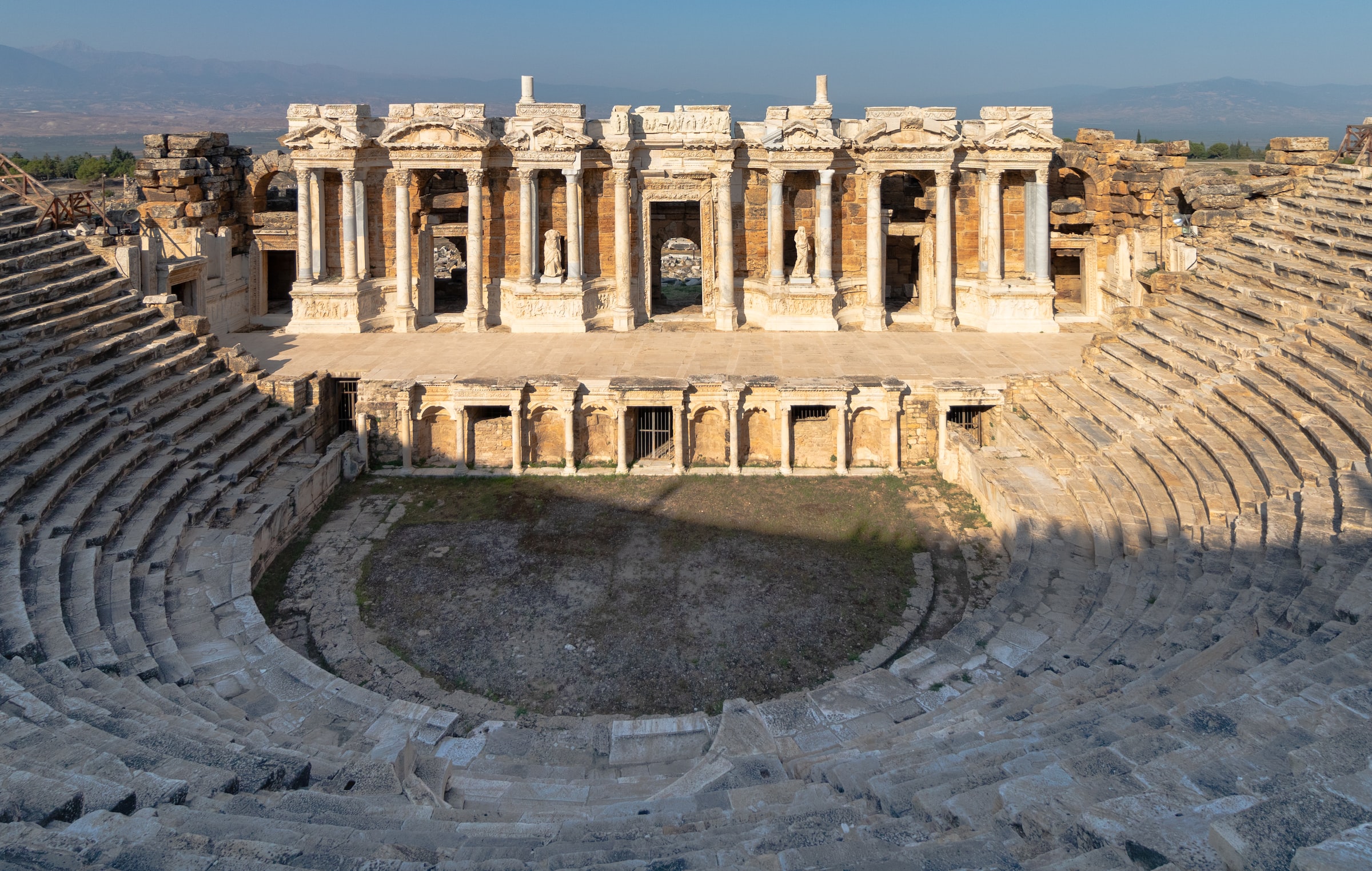
Hierapolis may not share the size or fame of Ephesus, but the experience here is actually much more enjoyable, thanks to natural marvels like the travertines and the hot springs, but most importantly because you can actually wander much of the ruins without feeling like cattle being herded through from entrance to exit – you have the time and freedom to explore and experience where you are, imagining what it would have been like almost 2 thousand years ago!
(Ephesus tip – Get there early and enter via the Harbour Street entrance to see most of the site before the big tour groups arrive!)
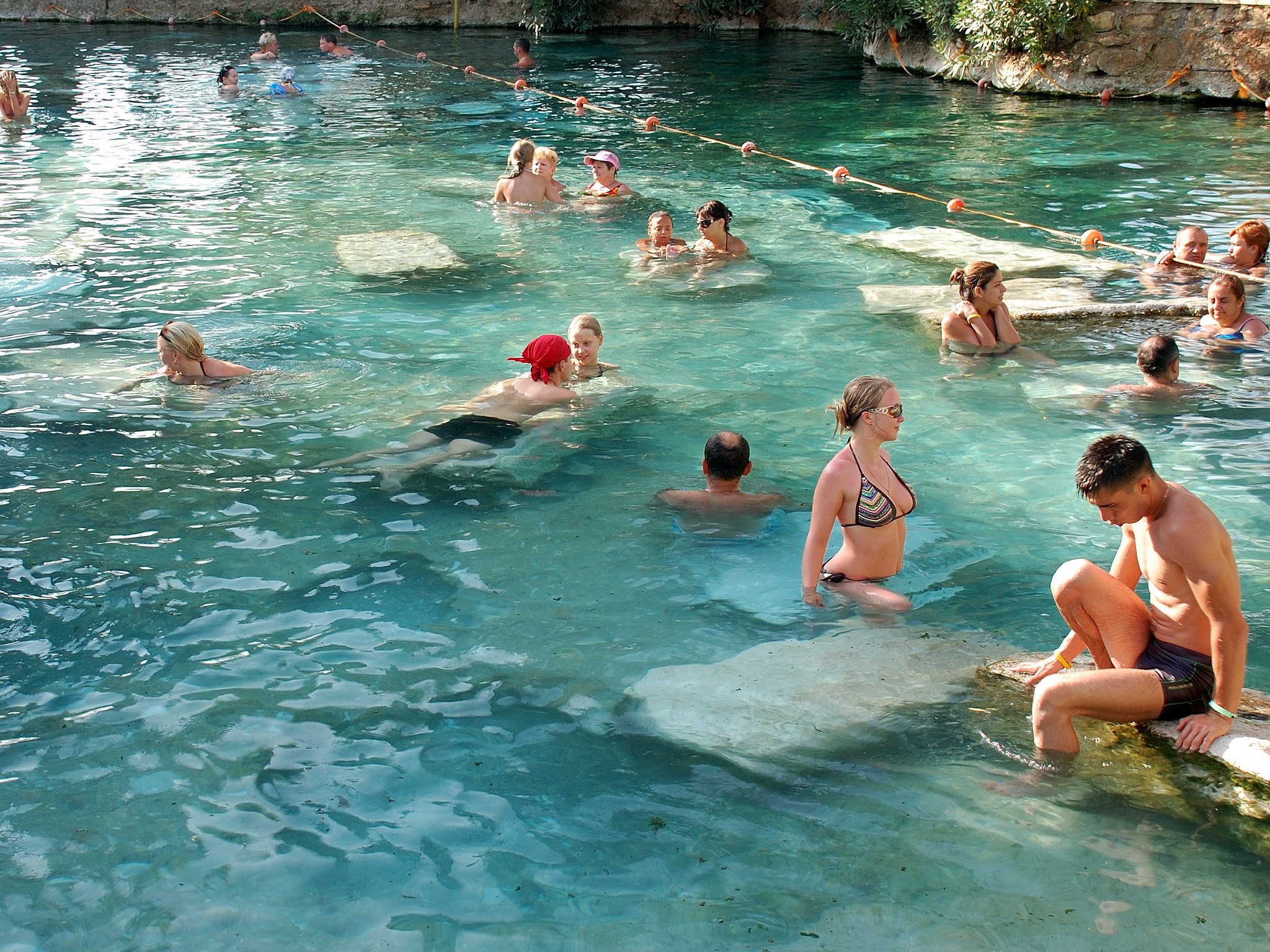
We highly recommend allowing more time to explore this little developed tourist spot of Pamukkale, which if all happens as promised, should only get better in the coming years!


















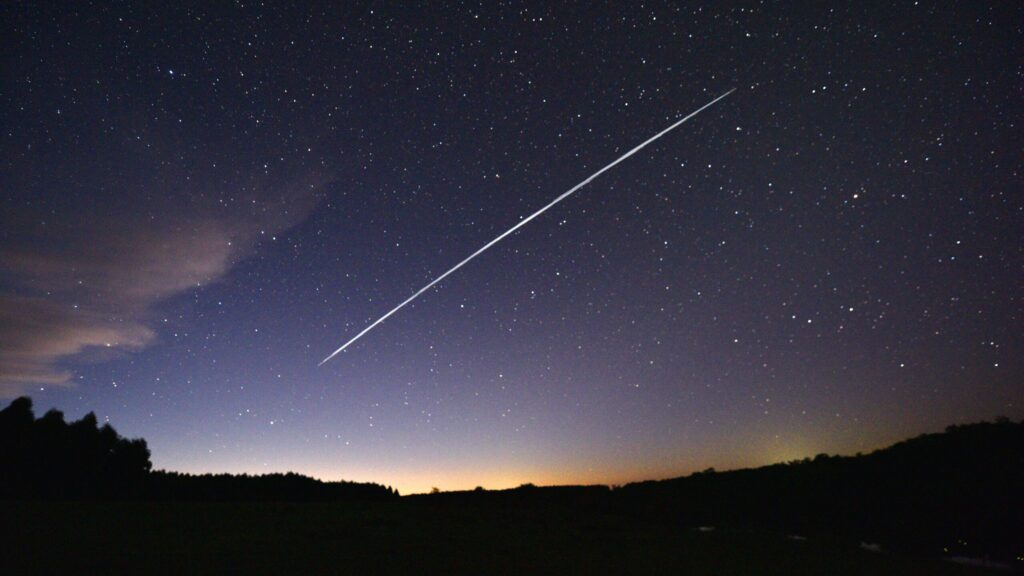

Discussion about this post